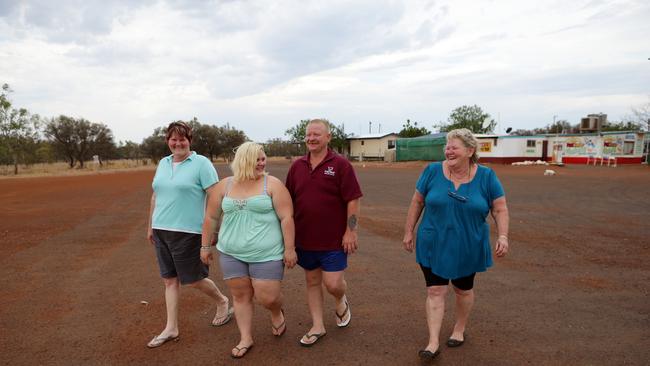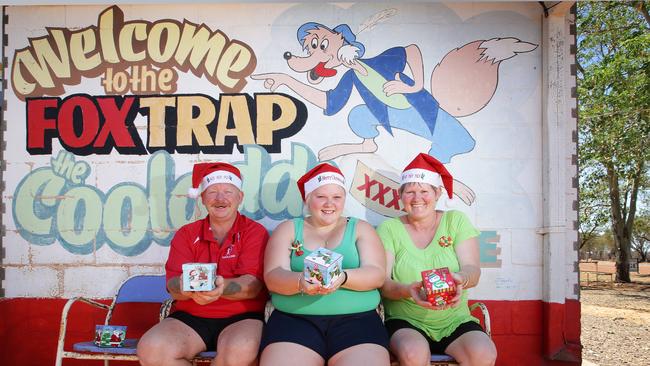Qld’s ‘ghost town’: What it’s like living in nation’s smallest town
With a population of just three, this town is officially Australia’s smallest. But it wasn’t always this way. So what happened, asks Dorothy Whittington.
QLD News
Don't miss out on the headlines from QLD News. Followed categories will be added to My News.
Today it’s famous for being the smallest town in Australia, but a century ago Cooladdi was a typical Queensland country community where everyone knew their neighbours and rallied through drought, bushfires and floods.
Residents would gather for race days, fundraising balls, sports days, Christmas parties and weddings.
Now a virtual ghost town with a population of only three, Cooladdi, 825km west of Brisbane, still has its own postcode.
It also has a railway siding and a hall as well as a roadhouse where its residents run the post office, general store, pub, restaurant and accommodation.
In its heyday as a rail centre between Charleville and Quilpie, Cooladdi had 270 residents. There was a school, post office, police station, and a hall, as well as a butchery, boarding house and store.

In 1910, the Great Western Railway Act authorised construction of over 2000km of railway in far western Queensland and Yarronvale, surrounded by pastoral holdings when sheep still ruled, was the railhead for local farmers to get their stock to market.
In 1914, the name was officially changed to Cooladdi, from the Aboriginal “black duck”, to avoid confusion with the Yarronvale sheep station 25km away. The town grew up around its railway station and for almost half a century it was a thriving Outback community.
It had its share of dramas. In December 1913, a train had a narrow escape from a bushfire when both sides of the line were ablaze and passengers were compelled to pull up windows and shutters to prevent the flames entering carriages. The fire was so fierce passengers said they were lucky to get through.
A month later, a cyclonic storm blew two train wagons with their brakes on down a dead-end siding. Both were damaged beyond use.
The Cooladdi State School opened in 1926 as a Provisional School with nine students. Seven years later, a new school building was constructed, and designated a State School.
Events that made the news in Cooladdi, could have applied equally to any other small Queensland town at a time when communities made their own fun and celebrated and mourned together.

William M. Hutchinson won the first prize of £5000 in the Golden Casket in 1931 and had plenty of friends rejoice with him. Many suffered in the heatwave of 1932 and, despite his good health, the aged blacksmith Harry Hasted collapsed and died.
Cooladdi Hall was a scene of gay festivity in 1933, when more than 100 guests danced until the early hours of the morning at a wedding that united two local families.
Two years after the infamous Bodyline Ashes tour, it was reported that it appeared to have been revived in the Cooladdi Post Office cricket match.
“Such was not the case, however. A matting was used, and the ball rose so frequently that the accidents were almost continuous. Bert Wilson had a glorious black eye reminiscent of his motor smash, while Reg Gaskin’s swollen lip was remindful of his boxing days. Vic Newton was another who suffered a nasty jolt on the forehead.”
In December 1940, almost the whole district farewelled popular Private Frank Dale at “one of the most enjoyable functions to be held at Cooladdi for many years”.
Dancing and community singing was interspersed with vocal and instrumental solos.
Ambulance Benefit race days were always a highlight.
Only two horses faced the starter for the coveted Boothulla Cup in 1950, but the Cooladdi Hall was crowded for the ball that evening.
The Cooladdi school closed in 1974 and now the only residents are Laurel Seymour, who moved in 14 years ago, and her daughter and son-in-law Roxanne and Gavin Muller who followed her soon after.

The family runs the Cooladdi Foxtrap, the town’s general store, accommodation, bar and post office, a stopover on the 1300km Diamantina Developmental Road between Charleville and Mount Isa.
It’s called the Foxtrap because the original owner, Bob Fox, welcomed the shearers who would come in and spend most of their pay cheques at the bar.
There’s still a hall that is used for meetings, but the gymkhana was put on hold during the drought.
For Cooladdi residents, Charleville is the big smoke. They still get their regular deliveries – milk once a week, frozen goods twice weekly and mail every day. The train stops twice a week at Cooladdi siding, although it’s for cattle only.
And Cooladdi is still the closest centre for those from surrounding stations to gather – one resident is happy to drive the 75km into “town”.
“There’s peace and quiet and no pollution,” Roxanne says. “It’s a great lifestyle. Where else would you want to live?”


